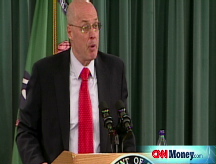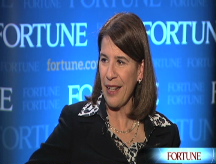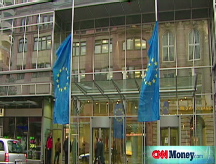Credit freeze: What Lehman wrought
Two months after Lehman Brothers' bankruptcy sparked a crisis of confidence, the credit markets are still healing.

NEW YORK (CNNMoney.com) -- Lehman Brothers' epic collapse two months ago marked a stunning turning point in the financial markets from which Wall Street is still recovering.
When investors woke up on Monday, Sept. 15, the landscape had totally changed: Lehman Brothers was bankrupt, Merrill Lynch (MER, Fortune 500) was sold off, and the credit markets - which had been improving after Bear Stearns' bailout in March - were in crisis.
Within two days, Libor, a key interbank lending rate, soared to an 8-month high of 3.06%.
Within a week, the market for commercial paper, a key form of business lending, had shrunk to a 2-1/2 year low of $1.7 trillion.
And within 10-days, two key measures of risk sentiment - the Libor-OIS spread and the TED spread - were at all-time highs.
Two months later, the credit environment has been slowly improving. Borrowing rates are retreating from historical highs, the commercial paper market is expanding and market gauges are showing a return of confidence.
But most economists believe it's still a long road to recovery.
"Letting Lehman go was a big mistake, because it was the catalyst that really triggered the refreezing of the credit markets," said Scott Anderson, senior economist at Wells Fargo. "Things are improving, but I don't think we're going to return to normal for quite a while."
Just two days after Lehman's bankruptcy, the government began to work on a massive financial rescue package. By October, the Federal Reserve and U.S. Treasury had four separate bank-liquidity programs in place that have lent out trillions of dollars to financial institutions.
The most talked-about program is the Treasury's $700 billion Troubled Asset Relief Program started in early October. The Treasury has so far sent out $125 billion to banks in the form of capital injections, with the promise of more to come. Banks have been criticized by lawmakers and the public for not using their TARP money for lending, but Treasury officials have said that the program will take time to realize its goals.
Meanwhile, the Federal Reserve has purchased $257.3 billion of commercial paper since its Commercial Paper Funding Facility opened on Oct. 20. In the same time period, the commercial paper market has expanded, but only by $154 billion. Analysts say the main lenders to businesses still don't want to take on risky corporate debt and are opting for U.S. Treasurys instead. The Fed has been hoping that its participation would encourage private lenders to reenter this once safe market.
The Fed has also stepped up lending programs that originated before Lehman's collapse. It expanded the amount it offers in its Term Auction Facility - a program that lends short-term money to banks in exchange for mortgage-backed securities - to $300 billion a month. And financial institutions continue to borrow hundreds of billions from the Fed's emergency lending window.
But for the past two weeks, Fed data has shown that banks are borrowing less from both the commercial paper facility and the discount window. Last week, the Term Auction Facility only attracted borrowers for 8% of its allotted bi-weekly loan. Some analysts have suggested that banks' borrowing needs have not decreased, but they are borrowing less from each facility because the government is providing funding from a variety of other programs.
"It's almost like banks have a buffet of liquidity choices," said Matt McCormick bank analyst and portfolio manager at Bahl & Gaynor Investment Counsel. "The Fed's trying to bail out a leaky boat with eight different types of buckets - no one cares what you call those buckets as long as they keep bailing."
The government programs have gotten credit back on track from the month-long derailment sparked by Lehman's collapse. And while some analysts argue that the credit "crisis" is over, the credit "crunch" is still very much alive and will be a slow process to correct.
"The government and investors want to be satisfied instantly, but they have to let things go through a normal business cycle," said McCormick. "The economy got beaten down to its foundation, and now we're building from bottom up again - I'd rather build slowly on much firmer setting than build quickly on made up statistics and shaky credit again."
Alan Greenspan, the former Fed chief, has said that we will know the credit markets have returned to normal when the Libor-OIS spread returns to just a hair above the anticipated Fed funds rate. That will show that banks are confident about the market conditions and have resumed normal lending practices. Libor-OIS was less than 0.8 percentage points before Lehman collapsed. It reached a record high of 3.64 on Oct. 10, and sits at 1.74 today. So according to Greenspan, we're only about half-way to recovery.
All the lending facilities and liquidity programs in the world won't encourage private lending on their own. Many have said the Fed can only push on a string.
There is an inherent problem in comparing Nov. 14 with Sept. 14. The global economic climate has taken a sharp turn for the worse since September, the stock markets have fallen drastically and the United States is likely in a recession. None of that was true two months ago, which means the government is fighting an uphill battle to restore liquidity.
In the days before Lehman declared bankruptcy, private lending was rebounding, and the credit markets were showing signs of improvement. Commercial paper was increasing to near one-year highs, risk indicators had fallen to normal market levels, and lending rates had hovered at around 3-1/2 year lows.
"One challenge we have in comparing today's situation with the situation before Lehman is that we weren't talking about a very very deep and extended recession in September," said John Silvia, chief economist for Wachovia. "Now we've been thrown that extra curve ball - not only has the liquidity issue changed but the economy has also changed."
To bring the credit market back to normal in a difficult economic time, it may take more than lending programs to boost liquidity.
Economists and lawmakers have suggested sweeping reforms, such as a clearinghouse for credit default swaps, private capital matches for TARP funds, a lending facility for consumer credit and a sweeping stimulus for taxpayers.
"The government has done just about everything it can do to provide liquidity," said Silvia. "The more fundamental problem going forward is what the regulatory framework is going to look like."
But if you're looking for a timeframe for these new programs to begin, check back in January.
"We need a substantial fiscal stimulus package," said Anderson. "Unfortunately, it doesn't look like much will get done until after the inauguration." ![]()




